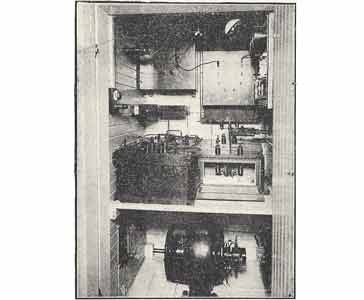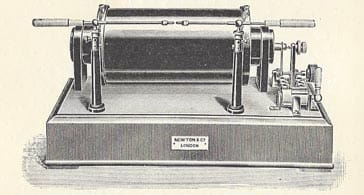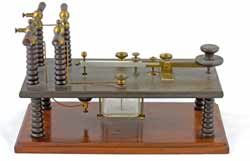Spark Gap Transmitter History
A summary of the history of the spark gap transmitter, detailing its introduction and the key dates and timeline of spark gap transmitter operation.
Spark Gap Transmitter History Includes:
Spark gap transmitter history
Operation
Poulsen arc transmitter
Spark gap transmitters were the first type of radio transmitter to be widely used.
As the name indicates the transmitters used a spark generated across a spark gap in the transmitter.
Spark transmitters were particularly widely used on board ships where they provided the first means of communication to shore based stations.

Early spark gap transmitter history
The spark gap transmitter was one of the very first forms of radio transmitter. It was the form of transmitter that Hertz used when he confirmed the presence of the electromagnetic waves that were postulated by James Maxwell when he developed his theory and the famous “Maxwell’s Equations.”
Although many people were experimenting with various forms of electromagnetic radiation at the time, it is Heinrich Hertz who is generally credited with showing these electromagnetic waves in a physical form.
It is thought that Galvani may have witness the effects of a spark transmission between 1780 and 1791 when he was struggling to understand the concept of electrical conduction.
Then over a century later, Joseph Henry showed that it was possible to magnetise steel needles at a distance of 10 metres using a spark that was about 2.5 centimetres long.
Edison was another person who observed the effect, and surprisingly for him he did not investigate it further. In 1875, he noted the effect and thought he may have discovered a new force in nature that he termed an etheric force. In an uncharacteristic lapse, Edison did not follow through on these investigations and develop them into a practical useful technology.
The work of Hertz is renowned as it was he who grasped the mechanism behind the transmission using sparks. After Hertz received his professorship at Karlsruhe he experimented with a pair of Riess spirals in the autumn of 1886. When he was performing these experiments he noticed that discharging a Leyden jar into one of these coils produced a spark in the other coil. This was effectively the first form of spark gap transmitter.
Between 1886 and 1889 Hertz conducted a number of experiments that proved the effects he was seeing with his spark transmitter were as the result of electromagnetic waves. Transmitting from his spark transmitter using a signal with a wavelength of about 4 metres he was able to set up standing wave patterns and also measure the speed of these signals, proving that they were essentially the same as light but with a different frequency.
Spark gap transmitter developed
The next key phase in the spark gap transmitter history was the practical development of the technique to enable real communications to take place.
Although Marconi did not invent radio, as many believe, and many others were active in the developing radio technology, he did a huge amount in developing the technology and enabling it to be used in a practical way.
Having hear much about the experiments of Hertz, Marconi replicated these experiments and then sought to improve the distance over which the signal could be transmitted.
Initially he used the same spark gap transmitting equipment as Hertz, but soon sought to improve it, making changes to both the transmitter and receiver.
Seeing the possibilities for commercialisation, but gaining no support in Italy, Marconi came to England where he was introduced to a number of leading scientists of the day in the field including William Preece.
Marconi steadily improved his wireless system including the spark transmitters, setting up various stations. He even placed one on a lightship on the notorious Goodwin Sands off the coast of Kent in South East England. This was able to communicate with the South Foreland Lighthouse. In one instance it was able to swiftly call for help when a ship collided with it in thick fog - thereby proving the usefulness of the wireless system.

The initial spark gap transmitters were not tuned and this reduced their effectiveness. Around 1899 to 1900, applying an idea developed by Oliver Lodge, Marconi added tuning to his transmitters (and receivers) This considerably improved their effectiveness. At this time tuning was referred to as ‘Syntony’. When using tuned circuits, Marconi referred to the antenna coupling / tuning assembly as a ‘jigger.’ In 1911, the Marconi company purchased the rights to the Lodge Syntony patent.
Marconi was not the only person developing spark gap transmitters. Several other people were looking at them around the globe including Ferdinand Braun in Germany, Tesla in the USA and Popov in Russia.
Sparks across the Atlantic
With spark communications starting to be seen as a way of communicating in some circumstances and longer distances being achieved, Marconi took on the challenge of sending messages across the Atlantic. Many thought this impossible, but undeterred he set about the task.
One of the key elements in the system was the spark gap transmitter required for this. The task of designing the spark gap transmitter was given to Ambrose Fleming, the Professor of Electrical Engineering at University College London.
Fleming developed an ingenious spark gap transmitter that used two spark gaps operating in cascade but at different frequencies. The circuit was powered by a twenty five kilowatt alternator.
Despite very many troubles, Marconi succeeded in sending a message across the Atlantic in one direction using this spark gap transmitter, although it was not found to be particularly reliable.

Note the insulators used to prevent arcing on the Morse key
More spark gap transmitter innovation
Even though Marconi had managed to send messages across the Atlantic, this was by no means the peak of spark gap transmitter technology. Further developments enabled the spark gap transmitter to operate even more successfully.
One of the major issues with spark transmitters was that the antenna circuit could feed back energy that would cause the spark to reoccur after the first burst of oscillations. This spark caused a signal to appear on a different frequency. As a result it was necessary to have a means of extinguishing or ‘quenching’ the spark.
Several ideas were developed to overcome this issue:
- Thomson’s magnetic blowout: This scheme was developed by Elihu Thomson in the 1890s and involved applying a suitably timed magnetic field at right angles to the spark.
- Air blast: This method, also developed around the 1890s involved applying a timed air blast to the spark to blow it out.
- Rotary spark gap: This method was initially proposed by Nicola Tesla in 1896 and involved using a rotary spark gap that was linked to an alternator providing the energising power. This enabled the spark to be synchronised to the times when the alternating voltage was at its peak. It was also improved by R A Fessenden in 1907 under US patent 706787. Marconi also produced his own version of this idea in 1907.
Understanding the spark gap transmitter
One of the key issues with the spark gap transmitter was that few people really understood its operation. In 1906, Professor Max Wein of Danzig in Germany published a paper in which he detailed his thorough analysis of the mechanisms behind the generation of radio signals using spark gap transmitters.
One of the main issues was that Wein showed that it was not necessary to use a long spark to generate a powerful radio signal. He also showed that it was possible to create a high level of efficiency and a single frequency by having close coupling between the spark circuit and the antenna circuit.
Poulson arc transmitter
The Poulsen arc transmitter is different from the ordinary spark transmitter, and although more efficient it never became as popular as the spark gap transmitter, although it was far more popular in the USA where the US Navy had a network of stations linking their bases by radio.
It was more complicated and the patent ownership restricted its use.
Read more about the Poulsen arc transmitter
Spark gap transmitter is overtaken
Although the spark gap transmitter was developed and improved to a very large degree, it could never compete with transmitters using valves that were able to create a proper single frequency signal. Spark gap transmitters were inherently wide band and although improvements in the design meant they occupied considerably less spectrum, they could never be as flexible and effective as those using valve based equipment.
As a result of this their use declined in the late 1910s and early 1920s. Although spark transmitters were retained for many years as a last ditch form of emergency communications on distress frequencies, they were ultimately rendered obsolete and their use banned as they caused interference to others.
Spark gap transmitter timeline
This timeline of the history of the spark gap transmitter gives a summary of some of the key dates of its operation.
| Date | Spark Gap Transmitter History |
|---|---|
| 1886 | Heinrich Hertz observed the first effects of spark transmission. |
| 1888 | Hertz confirms the properties of electromagnetic waves and uses a more developed form of spark gap transmitter. |
| 1895 | In the spring of 1895, Guglielmo Marconi starts experimenting with Hertzian waves using spark transmitting apparatus. |
| 1897 | Marconi’s specification for a wireless system was recorded with the British Patent Office on 2nd March 1897. |
| 1899 | Marconi uses a spark gap transmitter to make first transmission across the English Channel between Wimereux in France and the South Foreland Lighthouse in England |
| 1899 | Professor Ferdinand Braun of Berlin University uses a spark gap transmitter to transmit across the bay at Cuxhaven in Lower Saxony, Germany. |
| 1901 | On 12 December 1901, Marconi makes the first transatlantic radio transmission using a spark gap transmitter based in Poldu Cornwall, UK. The spark transmitter was designed by Ambrose Fleming of University College London. |
| 1903 | Poulsen arc transmitter invented. This transmitter was different from the standard spark gap transmitters and more complicated. Although invented in 1903 it was not as widely used. Its use was superseded by thermionic valves / vacuum tubes in the 1920s. |
| 1906 | Max Wien analyses the mechanism of spark transmission and sets out some improvements for spark gap transmitters. |
| 1911 | Roberto Galletti di Cadilhac develops a spark gap transmitter that provides 80% efficiency and improved waveform. |
| 1912 | The RMS Titanic sank on its maiden voyage with the loss of 1517 lives. While sinking Titanic contacted several other ships via wireless. This event caused several changes: spark-gap transmitters for wireless communications became almost universal on large ships. A year later, the International Convention for the Safety of Life at Sea was convened and required radio stations on ships to be manned 24 hours a day. |
| 1924 | Spark gap transmitters banned on amateur radio bands. |
 Written by Ian Poole .
Written by Ian Poole .
Experienced electronics engineer and author.
More History:
Radio history timeline
History of the radio
Ham radio history
Coherer
Crystal radio
Magnetic detector
Spark transmitter
Morse telegraph
Valve / tube history
PN junction diode invention
Transistor
Integrated circuit
Quartz crystals
Classic radios
Mobile telecoms history
Vintage mobile phones
Return to History menu . . .


